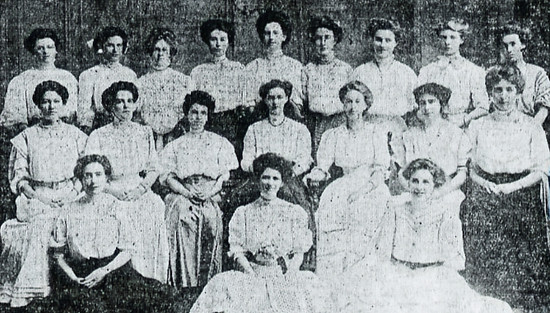Jamaica Training School for Teachers
Queens, New York
1897-1933
E-Travel
A 1997 Landmarks Preservation Commission document entitled “New York Training School/New York Model School” contains a history of the three teacher training schools of New York City. Coverage of sporting and other Jamaica Training School events often appeared in the Long Island Daily Press, digitalized by Old Fulton Postcards.
History
Jamaica State Normal School opened in 1897. In 1906 the school passed to the control of New York City and was renamed Jamaica Training School for Teachers. The Landmarks document notes that the schools were a popular route for potential teachers. They provided the candidates with educational theory, with opportunity for observation, and with practice in student teaching, as each site contained a model school. Graduates were required to pass an examination prior to receiving a license. The two-year program was increased to three years in 1923 and to four years in 1929. A Bachelor’s degree was added in 1931. The training schools peaked in the years 1923-29, as New York sought to train a sufficient number of elementary teachers. But even as the programs became more selective in admissions and more demanding of students, the number of unemployed teacher candidates increased, making a 10-year glut on the market. Finally in 1933, the three schools were closed.

Jamaica was the smallest of the three schools. The Annual Report of the City Superintendent of Schools shows 243 students with 68 graduates in 1916. In 1922 the total number of students was still only 277. Newspaper reports show that by 1928 the graduating class topped 100. The Landmarks document notes that all three training schools attracted far more female candidates—92 to 97 percent. By my count, of 78 Jamaica graduates in 1913, only one was male.
Newspapers note some school-sponsored activities such as a Senior class program with skits and music and class-sponsored dances.
Members of the 1908 Alpha Delta Sorority. The sorority had been formed at Jamaica Normal School in 1899. Image from the Brooklyn Daily Eagle.
Bricks and Mortar
The school opened in a new building at the intersection of Parsons Boulevard and Gilman Avenues in Jamaica. Built in 1897, it was a four-story brick and stone structure, part of which contained classrooms and part contained the model school.
In 1933 the building was used as an elementary school with rooms used to relieve the overflow from Jamaica High School. The website Forgotten New York notes that the building was finally razed in the late 1960’s. Hillcrest High School was built on the site.

Postcard view of Jamaica Training School (Forgotten New York <forgotten-ny.com/2008/12/jamaica-hills-queens/>) accessed 1-30-2017

1922 Long Island Daily Press image of Jamaica Training School high jumper Mary Moore participating in an interscholastic meet in Brooklyn. Image from Newspapers.com
Sports
Team name: Profs or Teachers
The first mention of sports at Jamaica Training School is in 1922 while it still had only a two-year program. At that time the basketball team began playing in the Greater Jamaica Basketball League against high schools and independent sides. Around 1925 we read that a J.T.S.T. baseball team is also playing against area high schools and the other training schools.
When the program was extended in 1923, and it became a four-year school in 1928, it is not surprising that the sports programs developed as well. The 1930 basketball team defeated Albany Normal School for the state championship among teachers' colleges. A victory over Long Island University in 1929 led to hopes for inclusion among major schools in sports.
In the fall of 1932 Jamaica played the first football game in school history, defeating St. Francis of Brooklyn 12-6.
In January of 1933 The Long Island Daily Press published an article of the big time aspirations, accomplishments and plans of Jamaica Teachers College, as it came to be known in 1929. The “Profs” were developing programs in five sports, hoping to attract the notice of the major colleges in the metro area. These included basketball, baseball, track, tennis and football. The closure of the school in June 1933 ended those dreams and plans.
Note: Images are used in accordance with their “terms of use” as I understand those terms. Recopying or republishing these images may be restricted or forbidden.